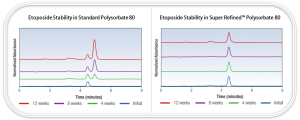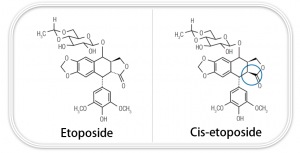Issue:March 2020
HIGH PURITY EXCIPIENTS - A Simple Solution to a Complex Problem
INTRODUCTION
It wouldn’t come as a surprise to anyone that active pharmaceutical ingredients (APIs) come in a wide variety. Small molecule, large molecule, peptide, monoclonal antibody, innovative, generic; the list goes on. These molecules have the ability to cure or mitigate debilitating conditions that can change a person’s life forever. It makes sense, then, that these ingredients are of primary importance in a formulation, and appropriate measures should be taken to maintain their stability and efficacy. As these APIs become more complex, they also become increasingly vulnerable to a series of different degradation pathways. Changes in pH environments can cause acidification and lead to breakdown. Exposure to moisture can initiate hydrolysis and subsequently lead to the formation of secondary byproducts. Residual catalyst that isn’t removed from an excipient can trigger side reactions and perpetuate degradation of not just the API, but everything else in the formulation. To combat this, formulators will typically front-load their formulations to compensate for this anticipated loss. However, this does not end up being a practical solution, as the degradants are still forming, and becomes an even bigger concern when the cost of developing the formulation becomes even higher. As a result, the more practical solution is to ensure that the remaining ingredients in the formulation are of the highest quality and purity. This certifies the drug will not degrade, and that efficacy and longevity are maintained.
IMPROVED DOCETAXEL RECOVERY VIA HIGH PURITY
Docetaxel is a great example of where the importance of purity plays a meaningful role. This active, a member of the taxanes class of molecules, is used as a chemotherapy drug, primarily in the treatment of cancers, including breast, lung, prostate, and stomach. Figure 1 depicts the main degradation product for docetaxel, 7-epi-docetaxel. With the same molecular weight as docetaxel, 7-epi-docetaxel is an epimer – a structural stereoisomer with the hydroxyl group at the C7 position (“flipping” position). Literature on the stability of the taxanes suggests that this is a common degradation product for docetaxel at that site, either through a retro aldol reaction or formation of an enolate intermediate.1,2 The formation of 7-epi-docetaxel has been observed in basic and strongly acidic conditions and in the presence of electrophilic agents, though the epimerization can be inhibited in the presence of a metal salt.3 7-epi- docetaxel has been found to be less cytotoxic to leukemia cells compared to docetaxel, so the formation of this epimer could reduce the efficacy of the treatment.4
A study conducted on docetaxel comparing its stability in various grades of polysorbate 80 (Figure 2) showed that there is significantly improved (up to 80% higher) recovery after 12 weeks at 40°C, when using a high purity grade rather than a standard compendial grade. Additionally, the study showed that there is a much higher concentration of docetaxel degradants, including 7-epi-docetaxel, present after these same conditions when using a standard compendial grade. This enhanced profile of docetaxel when using a higher purity grade of polysorbate 80, both during standard and accelerated conditions, shows that there are significant benefits from selecting the right grade of excipient when formulating.

Figure 2. Stability of docetaxel in various grades of polysorbate 80. Using Super Refined(TM) Polysorbate 80 yields a significantly higher percent recovery after 12 weeks at 40°C than using standard compendial versions of polysorbate 80. (click to enlarge)
MINIMIZING IMPURITY FORMATION OF ETOPOSIDE
Another chemotherapy API that is heavily prone to degradation is etoposide. Used for treating testicular, lung, and ovarian cancer, there are more than 300 marketed products incorporating this sparingly water-soluble active, with the bulk of the formulations incorporating polysorbate 80. In this instance, the main degradation product of concern is cis-etoposide, a stereoisomer of the active. Etoposide contains a trans-fused lactone ring that is under considerable strain, and will readily convert to the more thermodynamically stable cis-fused ring, known as epimerization. This altered structure can be seen in Figure 3. Literature suggests that cis-etoposide is biologically inactive in vitro, so any unwarranted conformation can have direct consequences on drug absorption and effectiveness.5 As with docetaxel, a study was conducted with etoposide to look at its stability in various grades of excipients for 12 weeks at 40°C, and it was shown that significantly more cis-etoposide is formed when it is formulated with standard grade polysorbate 80, with API recovery varying anywhere from 17% – 85%. However, when formulated with the high-purity grade, little to no cis-etoposide is formed over the course of the 12 week study, with near 100% full etoposide recovery. The results (Figure 4) also show using higher purity excipients can promote analytical clarity from a data processing standpoint, as impurity formation can cause the appearance of additional peaks in a chromatogram, adding to the time it takes to complete analysis. This, ultimately, suggests that using higher purity ingredients is crucial to maintaining your desired API concentration in your formulation, both in the short-term and in the long-term.

Figure 4. Chromatograms showing stability of etoposide in standard (left) and Super Refined(TM) (right) Polysorbate 80 over time. Etoposide appears at 4.4 minutes on the chromatograms, whereas cis-etoposide appears at approx. 5 minutes. Significant degradation can be seen in the standard version over the course of 12 weeks at 40°C, as indicated by the increasing impurity peak over time, whereas etoposide appears as one consistent peak over the course of the study. (click to enlarge)
POLYSORBATES FOR BIOPHARMACEUTICALS
It is well documented that biopharmaceutical actives, such as proteins and nucleic acids, readily undergo breakdown when exposed to various external stresses, including, but not limited to, heat, pressure, purification and finishing processes, mixing, and exposure to atmospheric conditions. As a result, this causes unfavorable interactions either within the protein structure or interactions with an external surface, ultimately leading to a decreased biologic efficacy. Additionally, these unfavorable interactions and product breakdown can be initiated through exposure to degradants found within the formulation.
In this scenario, the culprit is the excipient that the therapeutic agent is formulated with. While in minute quantities, one of the key ingredients that these agents are formulated with are polysorbates, specifically polysorbate 20 and polysorbate 80. Polysorbates are used in a wide variety of applications, with one of their primary uses being as a stabilization and surface adsorption prevention agent for proteins. Its inherent biocompatibility and strong ability to maintain internal protein structure also makes it a favorable choice over other stabilizers, like human serum albumin (HSA) and disaccharides.6 However, polysorbates are also notorious for undergoing auto-oxidation.
While the exact breakdown mechanism of these components is still unclear, it is theorized that the primary means are via acid or base-catalyzed hydrolysis or stress-initiated breakdown into aldehyde and acid subunits.7 These subunits not only further propagate the breakdown of the polysorbate, but also interfere with stability of the active ingredient. For this reason, it is imperative that the highest purity ingredients are used in these kinds of sensitive applications. Croda’s Super RefinedTM Polysorbate 20 and Super RefinedTM Polysorbate 80 has the low-impurity and high-stability profile that’s required of these applications.
THE REAL BENEFITS OF PURITY
The main concern with oxidative impurities in excipients doesn’t just pertain to active stability. Instability of the ingredient correlates to a number of concerns related to formulation and drug delivery. Chemical breakdown leads to the formation of species that can induce color, odor, and taste to an ingredient. Select impurities are known to be cellular irritants, inhibiting sufficient drug delivery and even inducing pain at the site of application. Additionally, small molecular weight impurities like formaldehyde can interfere with supplemental delivery vessels like gelatin capsules, altering or even preventing formulation release. These are normally common impurities that form as a result of poor control over the synthetic process, poor material handling and/or storage, or exposure of the material to undue stress. It is not just that a product should be synthesized with purity in mind, but also that the product should be handled with purity in mind. This isn’t just the case with polysorbates, but with all ingredients used in the manufacturing of pharmaceuticals. Proper precautions, such as critically controlling the cleaning protocols of vessels and inerting packaging and filling environments are crucial to excipient stability and, ultimately, product performance.
SUMMARY
As conditions evolve, so do APIs. Complexity in design and structure lead to tailored and efficacious delivery for those who need it most. However, with that increasing complexity comes more concerns for breakdown, and that breakdown extends beyond the requirement for a higher active loading as a means of compensating. Drug degradation can have toxicological effects in many instances, and it is imperative that this mechanism be minimized as much as possible. The best solution to this is to ensure that appropriate ingredients, both high in quality and purity, are chosen and used throughout the entire drug product lifecycle. Purity plays a key role in all facets, from drug substance synthesis to final product formulation to maintaining drug product integrity during administration. It is what ensures that products can be efficiently made without waste, that reactions can yield desirable product, and that the product that is formulated at the manufacturing site is the same product that gets taken by the customer.
Croda’s Super RefinedTM range of excipients are a testament to the term purity. With a wide range of ingredients available across the globe, coupled with expertise in numerous formulation and drug delivery areas, Croda offers a complete line of solutions that helps bring innovative breakthrough therapies to market. Super RefinedTM excipients are extensively purified to remove primary and secondary oxidation products, including aldehydes, hydroperoxides, and ketones, as well as residual catalyst from the synthetic process. This allows for a cleaner and clearer product that has a prolonged stability and shelf-life, as well as allows for better stability of any active ingredient that is solubilized in it.
REFERENCES
- Mclaughlin, Jerry L., et al. “19-Hydroxybaccatin III, 10-Deacetylcephalomannine, and 10-Deacetyltaxol: New Antitumor Taxanes From Taxus Wallichiana. Journal of Natural Products. 1981;44(3):312-319. doi:10.1021/np50015a013.
- Tian, Jiaher, and Valentino J. Stella. Degradation of Paclitaxel and Related Compounds in Aqueous Solutions I: Epimerization. Journal of Pharmaceutical Sciences. 2008;97(3):1224-1235. doi:10.1002/jps.21112.
- EP 2 330 100 A1.
- Bournique, Bruno, and Audrey Lemarié. Docetaxel (Taxotere) Is Not Metabolized by Recombinant Human CYP1B1 in Vitro, but Acts as an Effector of This Isozyme. Drug Metabolism and Disposition. 2002;30(11):1149-1152. doi:10.1124/dmd.30.11.1149.
- Essentials of Organic Chemistry for Stuends of Pharmacy, Medicinal Chemistry and Biological Chemistry, P. M. Dewick, Wiley, 2013.
- Arsiccio, Andrea, and Roberto Pisano. Surfactants as Stabilizers for Biopharmaceuticals: An Insight into the Molecular Mechanisms for Inhibition of Protein Aggregation. European Journal of Pharmaceutics and Biopharmaceutics. 2018;128(9):98-106. doi:10.1016/j.ejpb.2018.04.005.
- Kerwin, Bruce A. Polysorbates 20 and 80 Used in the Formulation of Protein Biotherapeutics: Structure and Degradation Pathways. Journal of Pharmaceutical Sciences. 2016;97(8):2924-2935. doi:10.1002/jps.21190.

Dr. William Small joined Croda in 2008, working in product applications for several business areas before moving in to the Health Care business in 2014. He provides applications support for high purity pharmaceutical excipients in parenteral, topical, oral, and other dosage forms, understanding how the purity and properties of an excipient impacts customers, formulations, and active ingredients. Dr. Small earned his MS in Chemistry and his PhD in Physical Chemistry at the University of Hull, United Kingdom.

Arsalan Khan joined Croda in 2015, and is currently a Technical Marketing Coordinator for the Health Care business. He started off in R&D, working on both new product development for new and innovative high-purity excipients, as well as generating applications data to support the use of Super RefinedTM ingredients. His current role involves helping to identify and serve customer needs through high-purity excipient solutions. He earned his BS and MS in Chemical Engineering from the New Jersey Institute of Technology, and his MBA from Temple University.
Total Page Views: 6714












